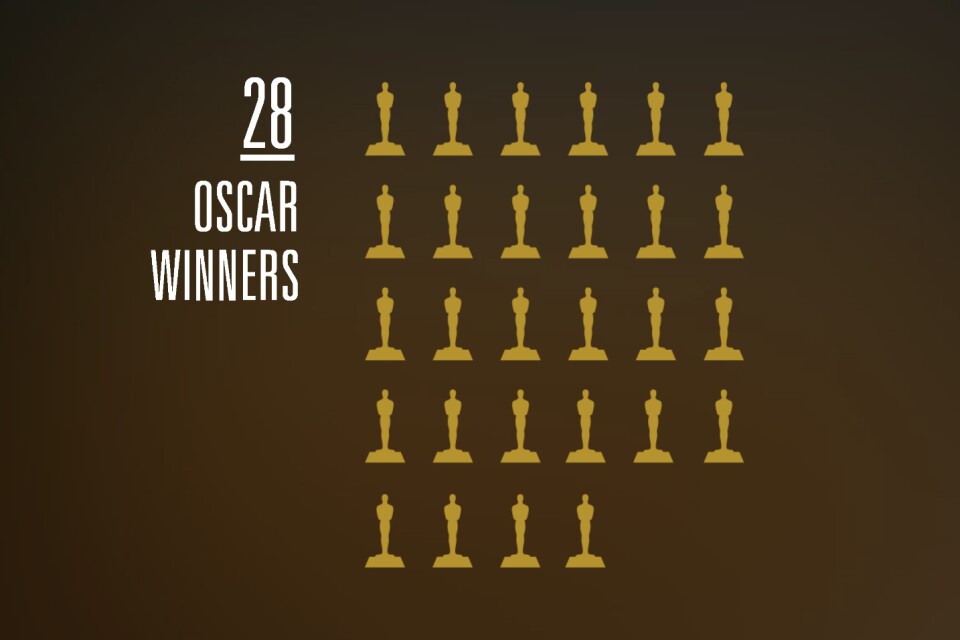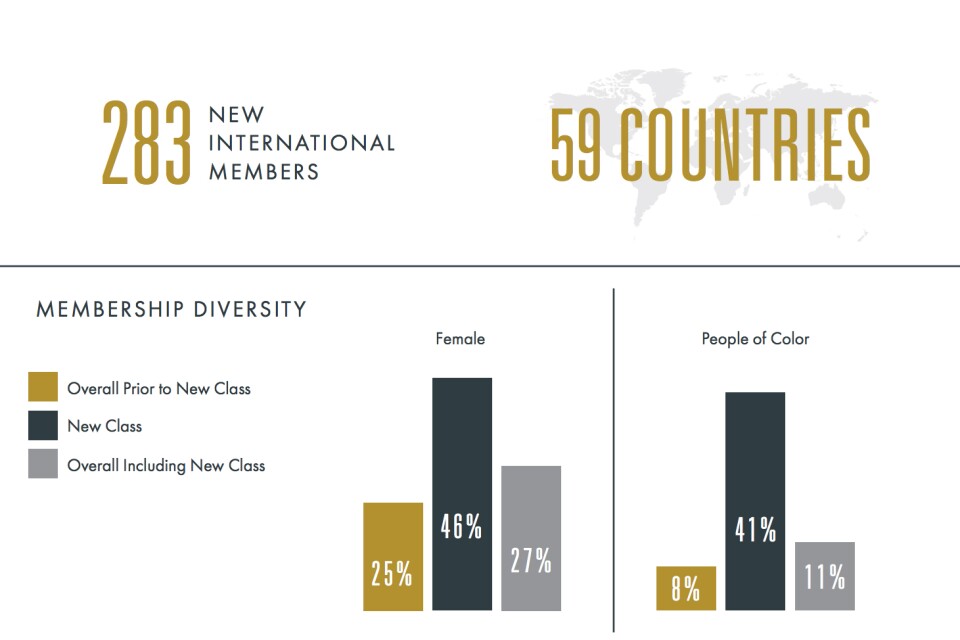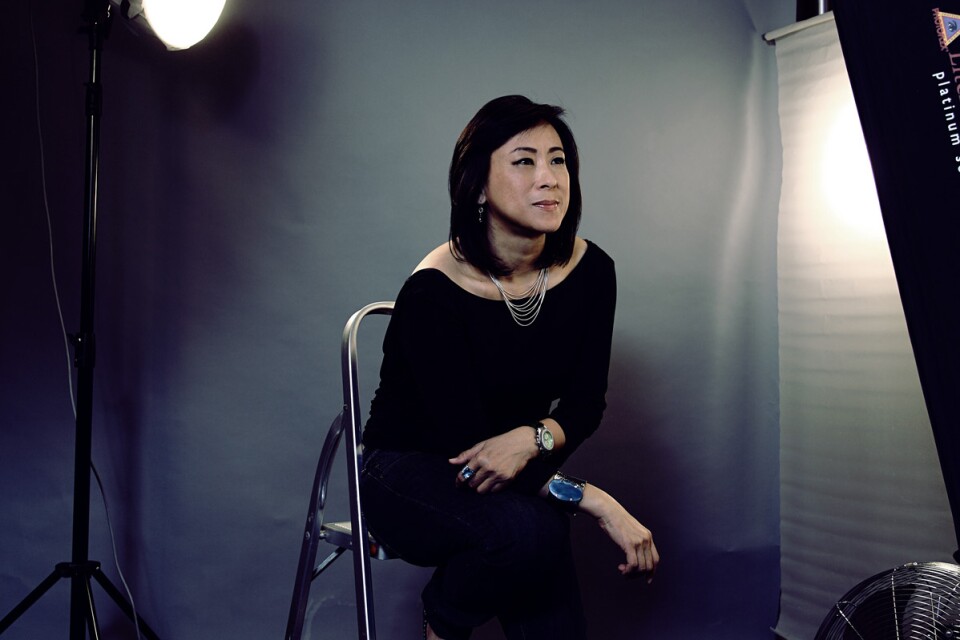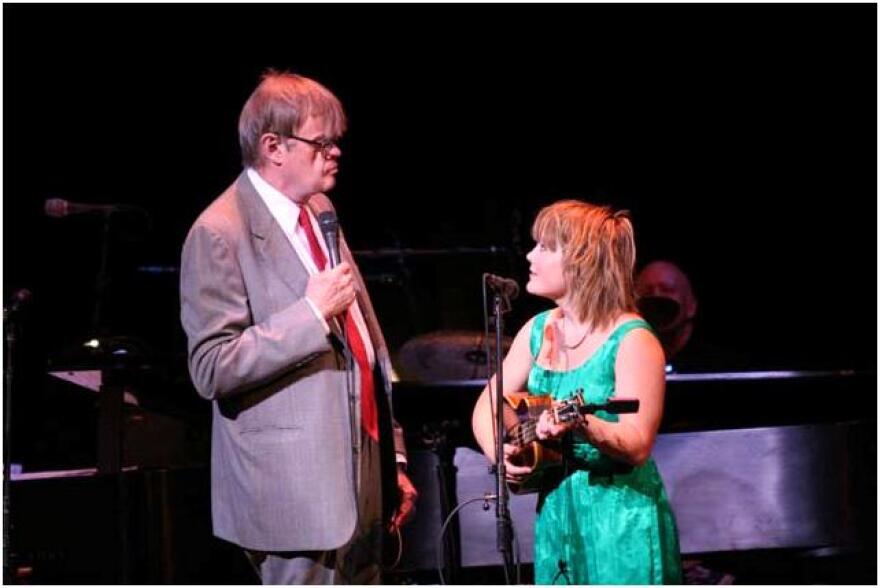July 1 is a big day for Sara Watkins: her new solo album is out and she performs on Garrison Keillor’s final “Prairie Home Companion"; Academy president Cheryl Boone Isaacs discusses the latest effort to diversify the historically white, male Hollywood institution; veteran visual effects supervisor Ellen Poon on what she learned in her first year as an Academy member.
Sara Watkins drops new solo album and bids farewell to Garrison Keillor
July 1st is circled on musician and singer Sara Watkins' calendar.
That day marks the release of her third solo album, "Young In All The Wrong Ways," and she’ll perform at the Hollywood Bowl on Garrison Keillor’s final “Prairie Home Companion.”
Watkins is a founding member of the band Nickel Creek and a longtime member of the "Prairie Home" family. In an interview with The Frame's John Horn, she discusses the inspiration behind her latest album, and the changes she's gone through between her start as a child prodigy and the latest phase of her solo career.
Interview Highlights
How did you come up with the title for your latest album, “Young In All The Wrong Ways?"
I think there are these transitional pivotal movements in everyone's life. I think for me there was probably a big moment when I was in my teenage years, then early 20s and then probably mid-20s. I feel like I just have gone through another course correction. Sometimes it happens very quickly. A few weeks go by and you think, Oh my gosh, I can't believe I did that! Who was I? You relate to yourself in a totally different way or you see the world in a different way and you think, I was so young. You don't relate to the world you did three weeks ago. Sometimes it takes a longer time to get to that point, but part of what I was trying to do deliberately as I was sensing this transition in life, was just to accept that disruption as a positive sign for moving forward and not getting stuck in ruts that I didn't intend to be in.
I think of your music as comfort food. It's simple ingredients composed organically and it makes you feel good even if the songs are a little sad. It feels like something you want to snuggle up to. Does that make any sense?
I'll take that as a positive experience.
It is! Definitely!
I think that, particularly in the past, that's been something in my first record certainly. It was developing some kind of home base. In the second record I did, it was stepping off of that. But I hope that, even in some of these songs that might feel sad or not overtly positive, there's a hope that comes out. I hope that's what you're finding comforting — some kind of redemption. Or a there's-always-a-chance-to-turn-it-around kind of thing. I am a comfort person. I like to think that I'm in the right or that I'm doing the the thing that's the best option for me at the time. But I don't want to rest on something just because I have in the past. I really enjoy challenging myself. I enjoy being in new places. It just takes a little bit of effort for me to keep putting myself in those places.
I remember 20 years ago having a conversation with Shawn Colvin, and she said that heartbreak is incredibly difficult to go through, but as an artist and a songwriter, it is the source of such great material [because] out of trials and difficulties comes really good music. She was very conflicted about it because she didn't want to be sad, but she knew it was going to create good material for her. Do you share that opinion?
Yeah, that's a common thought — A breakup? Aw, but I'll get some good songs out of it. But I think any story has to involve some kind of friction and some kind of conflict or challenge or fight. In these songs I'm talking a lot about friendships, other people's relationships, and my relationships to friends and to work and big picture stuff, and trying to be open to that conflict. There's one song called "Move Me" that was battling with feeling like there are a lot of relationships — old friendships, extended family — that needed to be tended to and that I felt ... you know, the holiday talk of just covering the same ground over and over again because you know that it's safe. You kind of just go through those motions and it feels like you might be keeping in touch, but you're not really digging in any deeper. You're getting straight to that bedrock and not getting into anything that seems like it might be a little dangerous. I needed to spur myself on and ask of others — these old friends — to be willing to dive into the murky waters in a dialogue rather than just people spouting off their monologues at each other, taking turns.
You've been touring since you were really young. It makes me think of the Bonnie Raitt song, "The Road's My Middle Name." Do you share some of the spirit of that song, that the road is, in some ways, your middle name?
I've been doing it so long. When Nickel Creek started touring for real, I was probably 18. I'm 35 now. I don't know who I am without that because it has affected so many things, so many choices I've made, and so many people and friendships and good and bad decisions. It's just a part of me. It's kind of hard to imagine life without it.
You have been performing with "Prairie Home Companion" since 2000. What does it mean that you're going to play with Garrison Keillor in his very last show?
I'm so pleased and happy and grateful to be able to be on that show. I've learned so much. I grew up listening to that show. I watched it when it was on the Disney Channel. As a family we watched it. I have this clear visual of the set that they have, that house, the on-air light, every time the music happens and then the light goes on and Garrison jumps in. It's this really special ceremony. I have these vivid, vivid memories of singing "America the Beautiful" to these people, many of them might be of the generation [who've] lived through World War II and beyond. They're singing these songs that hold a whole different weight. They have 80-plus years of memories attached to these songs. That show is just one-of-a-kind in this country and I'm so grateful to have had some up close and personal experiences on "Prairie Home."
But also there's a legacy that continues. Your Nickel Creek bandmate, Chris Thile, will be taking over, right?
Yeah, he takes over in October. I am so proud of him and so excited for him. I think there's no one else who could do a better job. The shows that he's done so far ... they're always hilarious, and musically they're just stunning. I'm really pleased and excited for him because I know he's such a fan of the show and of Garrison's. I think it's going to be a really exciting second act for the broadcast.
Catch Sara Watkins live at the Largo theater on Thursday July 7 for the "Young In All The Wrong Ways" release party. Click here for more details!
Motion Picture Academy president works towards diversity 'goals' not 'quotas'
The Academy of Motion Pictures Arts and Sciences which is responsible for the Oscars, has invited a record 683 new members into its voting ranks. And the Academy says this year’s class is its most diverse ever — 46% female, and 41% people of color.
After two straight years when the 20 acting nominees at the Academy Awards were white performers, and the talk surrounding the event was dominated by the hashtag #oscarssowhite, the Academy pledged to diversify its membership. The goal is to double the number of women and minorities by the year 2020. And the nearly 700 people invited to join this year will take the institution a long way towards that goal. But, unlike in past years, some of those asked to join the Academy have only a handful of film credits.
To discuss all of this, we called Cheryl Boone Isaacs, president of the Academy of Motion Picture Arts and Sciences. Below are excerpts of that conversation.
We also spoke with visual effects supervisor and producer Ellen Poon. She's worked in the business for 30 years and counts "Zootopia," "Frozen" and "Inception" among her credits. She became a member of the Academy in 2015 and tells The Frame's John Horn what it has meant to be included, and why her field is dominated by men.
Cheryl Boone Isaacs: president of the Academy of Motion Picture Arts and Sciences
Interview Highlights
What was the Academy’s process for choosing this group? Was this at all different from the way new members were chosen in years past?
Not necessarily. What it means is that is this business has expanded. There is a lot more diversity of product, actually. And a wider participation of filmmakers and skills that go into actually making motion pictures has grown. Different areas have increased substantially, whether it's in animation or visual effects. There is an explosion throughout the art form. We wanted to make sure that with this explosion and all of this talent, they become a part of the conversation. Because our organization is made up now of a little over 7,000 people, they represent all of the major facets of producing, marketing and distributing motion pictures.

What has historically been true about the Academy is that you've invited people with a body of outstanding work in film, and how you can define it varies from person to person. But some of the new invitees in this year's crop don't have a lot of credits or, in some cases, might not have worked on movies that are typically Oscar-worthy. So is the Academy changing its membership criteria?
No, the Academy has not changed its criteria. But I do want to point out that the Academy, every single year, looks at our rules and regulations in all of our areas just to make sure that we are staying current. The criteria is set by each branch. It isn't just a group of people in a room who are deciding across the board. It is by our 17 different branches. I stated before that there are many different changes in aspects of the art form and the skills that it takes to put together a motion picture. So it's an evolving situation year-in and year-out. It is impossible actually to compare, let's say the year of 2016 to the year of 1964. You can't do that because the art form has changed.

In what way does this new list of members reflect a new purpose of the Academy? Do new members still need to have two current members endorsing?
The way that we use is to be sponsored by members in your branch. The last few years, because we recognize that there are folks out there that were not really savvy about the process, we asked our members [to] look around, pay attention. [They] are our ambassadors out there on a day-to-day basis. Who's out there that's not part of this conversation that's not an Academy member? We'd like to hear from you in recommending these young — or any age, actually — men and women that are not part of our ranks that we would like to have. That is also part of why this class is the size that it is, because our members got very much involved.
You and the Academy leadership said you want to double the number of women and minorities — currently about 1,500 and 535, respectively — in your ranks by 2020. Is that still the goal?
Yes, that is our goal and we are sticking to our goal. That is for sure. And [to] keep going. It's not like we're going to get to 2020 and say, Okay, we've done this, we're done. It's just going to keep going. But you have to set goals. And the word is goal. The word is not quota. So at the end of 2020 — this new goal that we have set — we can look at and be proud of the advancements that we have made.

Ellen Poon: visual effects supervisor/producer
Interview Highlights
When you are invited to join the Academy, do you get a phone call in the middle of the night? Does someone tap you on the shoulder and say you're in? How do you actually find out that you've joined the club?
They release all the names together to the press. So you go through the Variety news article and then you find out your name is on it. It's kind of like winning the lottery.
That's the whole point, right? It's an exclusive club. You have been working in the visual effects field for many decades, but you were just invited to the Academy last year. Why do you think it took so long?
In the past what happened was there was a quota, and only when a member passed away or if that person decided to leave the Academy, then they would accept new members. So it was a very small community. Then when Cheryl Boone Isaacs came in as president, she decided to expand that community by increasing that quota. Also, I think she had that awareness a few years ago that we needed to diversify the Academy. It used to tend to be white male and slightly older as well. She realized that does not reflect the community at this point in time. So she increased the quota. You have to be sponsored by two members and they both have worked with me for a long time and they [said], We need people just like you to be in the Academy — female, from a diverse background, worked in international productions and have a lot of experience in this field. And not afraid to voice your opinion as well. So they proposed my name. The Academy does not pick out names from a hat. You have two members sponsoring you and then they have a list of people and potential candidates and they go through many meetings to narrow down who they think should be invited into the Academy.
Your branch of visual effects, according to the Los Angeles Times in the study that was released a couple of years ago, it's 97% male and 95% white. Why does visual effects — and there are certainly other branches within the Academy that are very similar — look like that in today's world?
That's a very interesting question. I asked the same question myself. Most of the departments that I work in only have a few non-white workers. I have to say, it did start off having more white males being the managers or being the supervisors, and they tend to like a crew that look the same or have the makeup that they identify with. When I was a visual effects supervisor on certain projects, I felt like the director — which was most of the time a male, especially in these big effects movies — tended to want a more male-dominated crew. Especially when they think about visual effects, they always see that as more of a technical exercise instead of a design-plus-technical exercise. So they want to surround themselves with more of a male crew. But that's something I think, if we work harder we can change that. You just have to be very, very vocal. You have to be very, very strong, both technically and artistically, in order to fight that fight.
I want to ask more about that. You have a company, Lancet Films, and you're a member of the Academy. As you're thinking about the kinds of people that you want to hire for your company, are you mindful that it's a field which historically has been dominated by white men? Also, now as a member of the Academy, are you going to be active in sponsoring and reaching out and recruiting other people who are not white men to join the Academy?
Yes, yes. I'm always looking out for the best people. As a supervisor/producer, I would reach out to many different people to make sure that I'm hiring people for the right job. I have no problems promoting females from a non-white background. Anyone who is capable in doing his or her job, I would definitely suggest that as a potential member to the Academy.
2016 Academy invitees who have previously appeared on The Frame:
ACTORS
DIRECTORS
DOCUMENTARY
MUSIC
PRODUCERS
WRITERS
ASSOCIATE MEMBERS




